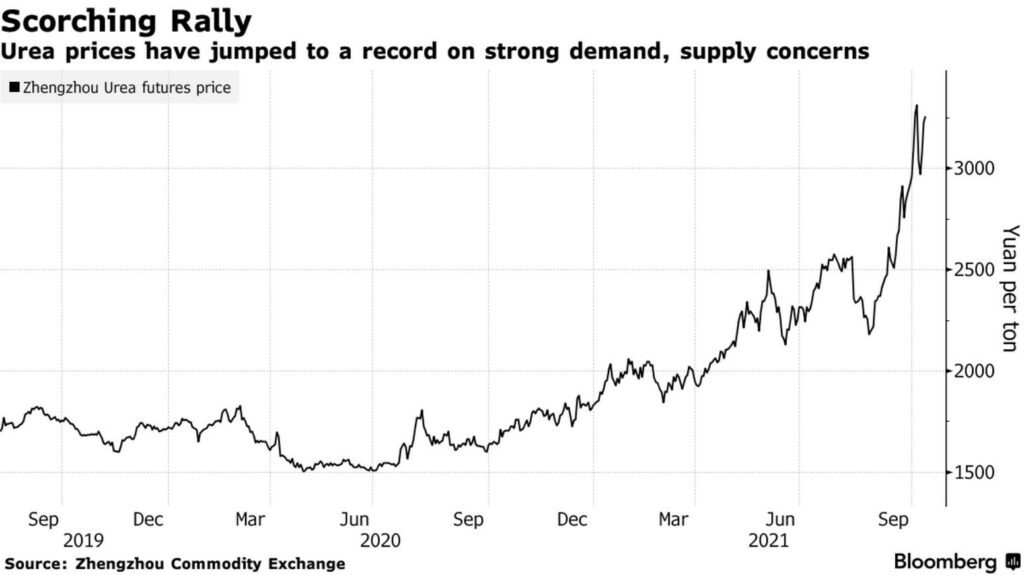Economist and Farmer Michael Smith Introduction Well, Its About to Become Worse as Urea prices jumped to a record strong demand creating supply shortages. Food prices to increase . . . And the Details I was recently sitting on a conference call with a fertilizer analyst and a bunch of monocrop growers, generally feeling out of place with my few dozen pounds of peppers, cucumbers and radishes sitting in cold storage while they go over current state of affairs of tons of this and that. We had a good year collectively as a country and a ag sector. We’re almost at a bushel for corn and if that hits, one mono guy owes me a case of beer. The inflation piece was the inflection point in the conversation. Equipment and land buys were at
Topics:
run75441 considers the following as important: Farming, Fertilizer, Michael Smith, US/Global Economics
This could be interesting, too:
Joel Eissenberg writes How Tesla makes money
Angry Bear writes True pricing: effects on competition
Angry Bear writes The paradox of economic competition
Angry Bear writes USMAC Exempts Certain Items Coming out of Mexico and Canada
Economist and Farmer Michael Smith
Introduction
Well, Its About to Become Worse as Urea prices jumped to a record strong demand creating supply shortages. Food prices to increase . . .
And the Details
I was recently sitting on a conference call with a fertilizer analyst and a bunch of monocrop growers, generally feeling out of place with my few dozen pounds of peppers, cucumbers and radishes sitting in cold storage while they go over current state of affairs of tons of this and that. We had a good year collectively as a country and a ag sector. We’re almost at $6 a bushel for corn and if that hits, one mono guy owes me a case of beer.
The inflation piece was the inflection point in the conversation. Equipment and land buys were at all time highs this year in both rate and price, and almost all financed. The inflation piece when financed is not transitory. Those excess prices sustain in each biting month in which they are due over the next 14 months to 5 years, or even longer if it was a land loan.
This then got wrapped into the conversation of now that debt loads have been pushed up.
What does 2022 and beyond look like?

With China curbing its exports of fertilizers, China’s Curbs on Fertilizer Exports to Worsen Global Price Shock – Bloomberg and Russia following suit, the net effect on input prices has risen from $160-$180 a ton on a normal year to close to $1,000 per ton for next year just for urea (nitrogen from the big three NPK).
Farmers start deciding what to plant now, ahead of the spring crop year and start buying the things they will need now. As input costs and future contracts for those inouts have only gotten worse, the futures contracts for the produce commodities haven’t really changed much. So, commodities traders are waiting to see what the farmers do.
From my seat
Farmers are planning to produce things that don’t need a lot of inputs. Corn relies a lot on nitrogen and without adequate supply, the harvest can be stalled by two weeks. So that’s out. They will switch to milo, or if cotton is looking like a good price, go that direct. Problem is, when everyone runs to one end of the boat, it risks tipping over. Sure, some guys will grow corn and silage and all the things that feed into the food supply, but with less supply means higher prices. The farmers will need that all around, and will plant less acres to achieve that. Not in a collusion sense, more of a cost control or not plant at all because they can’t get fertilizers to begin with. Crop insurance can only do so much.
On a call I asked,
“In Texas we flare off a ton of natural gas, so it seems to me someone could use that in their factories and we could bump up domestic production, right?”
Josh Linville of StoneX Analytics in Kansas City, MO,
“Mike that is a great question”
No it wasn’t. But he humored me.
“Cost of building new production capacity is $5 Billion and takes about 3-5 years to build a factory. We currently have 3 fertilizer plants running at max capacity in the US. And I’ll tell ya, $5 billion is a lot of money…chemical producers can do a lot of other things with $5 billion. The risks with adding anything domestic is once the energy issues in China and Europe wane, and everything levels out summer of next year, they are sitting on huge debt. Also doesn’t help that the political atmosphere on energy changes seeming every 4 years. So, no, increase of domestic production isn’t in the works as far as we see.”
Next Year
Looking toward next year farmers are now scrambling to find the inputs, figure out what the best thing to plant for the return will be, how much they can afford to plant, and ultimately thinking about the dramatic increase of overhead costs and the loans associated with all of it.
The expectation is the middle of next year it should level out but the asterisk says *we will have to wait and see. This means, short term base inputs into all manner of the food system will increase again. Sustained inflation in food costs is likely going to stick around a lot longer than anticipated. To top it all off, we will most likely see operations cease, go bankrupt as their return on crops might not be enough to cover their loans. Interesting times ahead as the interconnectiveness of energy, food, and consumer spending shows pains from a broken system.
